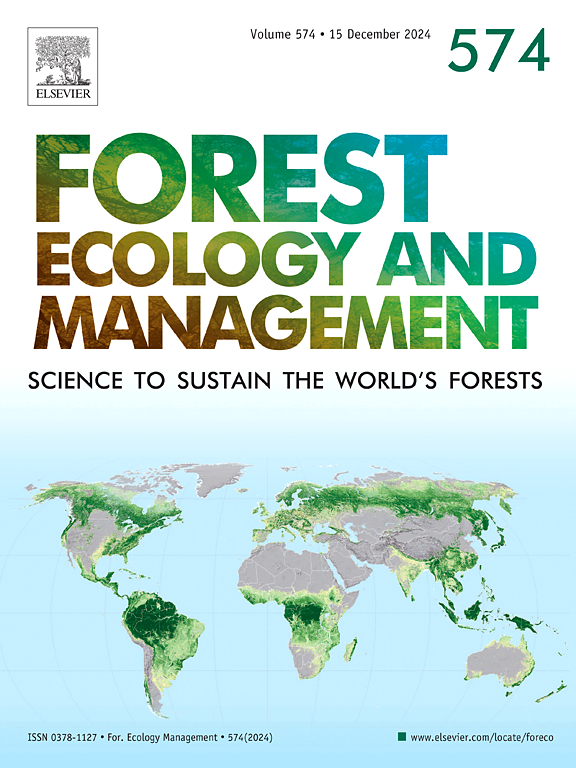Environmental flows and microsite attributes influence floodplain eucalypt recruitment
IF 3.7
2区 农林科学
Q1 FORESTRY
引用次数: 0
Abstract
Globally, river regulation and water extraction for anthropogenic use have altered the hydrology and ecology of riverine and floodplain ecosystems. Managed environmental flows are increasingly being implemented to restore the condition of many riverine and floodplain ecosystems. In the Murray-Darling River Basin, south-eastern Australia, appropriate flooding regimes are key to maintaining populations of the dominant floodplain forests and woodland trees, River Red Gum (Eucalyptus camaldulensis) and Black Box (E. largiflorens). We investigated the effects of three environmental flow events and microsite attributes (bare ground, canopy and understorey vegetation) on eucalypt recruitment over a five-year period across a semi-arid floodplain gradient (lake bed, lower and higher floodplain). Eucalypt recruitment increased after the environmental flows. The probability of recruitment declined with increasing elevation along the floodplain gradient, with the highest occurrence on the lake bed and lower floodplain where River Red Gum dominates. Recruitment on the higher floodplain, where Black Box is dominant, was low, suggesting that factors other than flooding (e.g. poor tree health) may limit regeneration. Recruitment also increased with increasing cover of bare ground and understorey vegetation. Saplings (>1 m) were more likely to occur on the lower floodplain, where understorey vegetation cover approached 50 %, suggesting that the germination and survival niches of eucalypts may differ. That is, bare ground is necessary for germination, while understorey vegetation may provide protection to seedlings from desiccation and browsing. The combined flood events likely benefited the survival of pre-established seedlings by limiting the effects of summer desiccation and increasing soil moisture availability. There may be a trade-off between managing environmental flows for seed germination versus seedling survival. Future environmental flows that target the higher floodplain are likely to contribute to improvements in tree health, reproductive output and subsequent recruitment opportunities in this floodplain ecosystem. This study shows that environmental flows likely contribute to the maintenance of sustainable eucalypt floodplain forests and woodlands through the facilitation of recruitment and seedling persistence.
环境流和微观地点属性对洪泛平原桉树新梢生长的影响
在全球范围内,河流治理和人为取水改变了河流和洪泛区生态系统的水文和生态。为了恢复许多河流和洪泛平原生态系统的状况,人们正在越来越多地实施环境流量管理。在澳大利亚东南部的墨累-达令河流域,适当的洪水机制是维持主要洪泛平原森林和林地树木--河红桉(Eucalyptus camaldulensis)和黑盒子树(E. largiflorens)--数量的关键。我们研究了三个环境流事件和微观地点属性(裸地、冠层和林下植被)对半干旱洪泛平原梯度(湖床、较低和较高的洪泛平原)五年内桉树更新的影响。环境流过后,桉树新梢增加。随着洪泛平原梯度海拔的升高,桉树移生的几率下降,湖床和低洪泛平原的移生几率最高,河红胶在这里占主导地位。在黑箱树占优势的高洪泛平原上,更新率很低,这表明洪水以外的其他因素(如树木健康状况不佳)可能会限制再生。随着裸露地面和林下植被覆盖率的增加,再生率也在提高。树苗(>1 米)更有可能出现在下洪泛区,那里的林下植被覆盖率接近 50%,这表明桉树的发芽和存活环境可能有所不同。也就是说,裸露的地面是桉树发芽的必要条件,而林下植被则可以保护桉树幼苗免受干燥和啃食。综合洪水事件可能会限制夏季干燥的影响,并增加土壤水分的可用性,从而有利于幼苗的存活。在管理环境流量以促进种子发芽和幼苗存活之间,可能需要权衡利弊。未来针对高洪泛区的环境流量很可能有助于改善该洪泛区生态系统中的树木健康、繁殖产量和后续招募机会。这项研究表明,环境流很可能通过促进桉树幼苗的恢复和存活,有助于维持可持续的桉树洪泛平原森林和林地。
本文章由计算机程序翻译,如有差异,请以英文原文为准。
求助全文
约1分钟内获得全文
求助全文
来源期刊

Forest Ecology and Management
农林科学-林学
CiteScore
7.50
自引率
10.80%
发文量
665
审稿时长
39 days
期刊介绍:
Forest Ecology and Management publishes scientific articles linking forest ecology with forest management, focusing on the application of biological, ecological and social knowledge to the management and conservation of plantations and natural forests. The scope of the journal includes all forest ecosystems of the world.
A peer-review process ensures the quality and international interest of the manuscripts accepted for publication. The journal encourages communication between scientists in disparate fields who share a common interest in ecology and forest management, bridging the gap between research workers and forest managers.
We encourage submission of papers that will have the strongest interest and value to the Journal''s international readership. Some key features of papers with strong interest include:
1. Clear connections between the ecology and management of forests;
2. Novel ideas or approaches to important challenges in forest ecology and management;
3. Studies that address a population of interest beyond the scale of single research sites, Three key points in the design of forest experiments, Forest Ecology and Management 255 (2008) 2022-2023);
4. Review Articles on timely, important topics. Authors are welcome to contact one of the editors to discuss the suitability of a potential review manuscript.
The Journal encourages proposals for special issues examining important areas of forest ecology and management. Potential guest editors should contact any of the Editors to begin discussions about topics, potential papers, and other details.
 求助内容:
求助内容: 应助结果提醒方式:
应助结果提醒方式:


